The fierce battle for "southern Kronstadt"
prehistory
The growing Russian Empire was rapidly solving the task of returning the Northern Black Sea region, the Russian (Black) Sea under its control. After the Russian-Turkish war 1768 - 1774, the position of the Ottoman Empire in the Black Sea region continued to deteriorate. Russia joined 1783 in the Crimea, Taman and Kuban. The robber state formation of the Crimean Tatars, which for centuries brought great damage to Russia, was eliminated. Russia began to quickly develop a new region - to build cities, fortresses, ports, shipyards, to develop the economy and settle new lands. A new fleet is being built - the Black Sea; its main base has become Sevastopol. Also in 1783, Russia concluded an agreement with the Georgian kingdom of Karli-Kakheti (Eastern Georgia) on the protection of the sovereign power of the Russian tsar. As a result, according to the Georgievsk Treaty, East Georgia passed under the protectorate of the Russian Empire.
Thus, Russia has significantly strengthened its position in the Black Sea region and in the Caucasus. Turkey continued to lose influence in the region. She quickly oppressed the Russian Empire. Port began to prepare for a new war. In 1787, the Ottoman Empire, behind which stood the great European powers (England, Prussia and France), concerned about the movement of Russia in the south, issued an ultimatum to St. Petersburg demanding the restoration of the former position of the Crimean Khanate and Eastern Georgia (vassals of Turkey). The Turks also sought permission to inspect Russian ships passing through the Black Sea straits.
Having been denied its arrogant demands, on August 13, 1787, Turkey declared war on Russia. The main goal of the war of the Port was the return of Crimea under its authority, a strong fleet with a landing corps and the strategic fortress Ochakov near the mouth of the Dnieper should have helped this. The Russian fleet had just begun to build, so in Constantinople they hoped for their rule fleet at sea, which was to become a decisive factor in the war for the Crimea.
Map source: Great Soviet Encyclopedia (TSB)
War
In an effort to use the fact that Russia was not ready for war, the Turks attacked first. The Turkish fleet went to Kinburn and 1 (12) October landed troops. However, the Turkish forces were exterminated by a detachment under the leadership of Suvorov. The Russian commander had only 1600 people. A 5500 man landed on the Turk - 5000 was killed and sunk. This completed the 1787 campaign of the year. Turks after such a terrible pogrom no longer took active steps.
In winter, Russia cemented the anti-Turkish alliance with Austria. Porta decided during the 1788 campaign of the year to strike a decisive blow at the Austrians first. Against Russia confine strategic defense, strengthening the fortress on the Danube front. The main striking force against Russia was the fleet, the Turkish naval forces were to support Ochakov, and attack Kinburn and Kherson. Russia to the beginning of the campaign formed two armies. Home - Yekaterinoslav under the authority of Potemkin (82 thousand people and 180 guns), had to attack from the Dnieper through the Bug and the Dniester to the Danube, take strong fortresses - Ochakov and Bender. The auxiliary army of Rumyantsev (about 37 thousand people) was to go to the middle course of the Dniester, to establish contact with the Austrian allies. A separate Russian detachment was located in the Kuban to protect the frontiers from the raids of the Kuban Tatars and the Highlanders. Austria led military operations in the Serbian sector, and sent a corps of Prince of Coburg to Moldova to communicate with the Russians.
The 1788 campaign of the year was conducted by the Allies sluggishly and unsuccessfully. The army of Potemkin only in June crossed the Bug and in July besieged Ochakov. The Turkish fortress was of strategic importance, being one of the main strongholds of Turkey in the Northern Black Sea region. Here was located one of the bases of the Turkish fleet. Ochakov allowed to control the exit from the Dnieper-Bug estuary (the Dnieper and the Southern Bug flow into it) into the Black Sea. The Turks, with the help of French specialists, had time to prepare the fortress for defense by the start of 1788, to strengthen the garrison, restore the old ones and prepare new fortifications. Ochakov fortress adjoined one side (the least protected) to the Estuary. The walls were covered with a rampart and shaft. On the approaches to the fortress itself there was the first line of defense - earthworks. On shafts and walls it was found around 300 guns, on field fortifications - 30 guns. Separate from the fortress, on top of the Ochakov Cape, stood the Gassan Pasha castle. The fortress was provided with food and ammunition based on a long siege. In addition, the garrison of the fortress was counting on the support of the Turkish fleet. As a result, the siege dragged on until December 1788. Ochakov was overlaid with land by the army, and from the estuary - by a flotilla that successfully repulsed all the encroachments of the Turkish fleet.
It is worth noting that the young Black Sea Fleet acted very actively and decisively against the enemy fleet, trying to help its fortress and the Dnieper Turkish flotilla. In the battles of June 7 and June 17, the Russian Dnieper flotilla under the command of admirals John Paul Jones and Carl Nassau-Siegen, captain Panagioti Alexian, repulsed the attacks of the Turkish fleet. On the night of June 18, the Turkish fleet decided to leave Ochakov and, during the withdrawal, came under fire from coastal batteries installed by Suvorov. The defeat was completed by the rescued Russian ships (The defeat of the Turkish fleet in the battle of Ochakovo). The Turks in the two-day Ochakovo battle suffered great losses: 15 ships, including 5 battleships and 5 frigates, which were about 500 guns. Turkish sailing fleet was forced to leave for Varna. On July 1, the Russian flotilla finished off the Turkish Dnieper flotilla from Ochakov. On July 3, the Russian sailing squadron under the command of Voinovich and Ushakov defeated the Ottoman fleet at Fidonisi (Battle at Fidonisi). In late July, the Turkish fleet again went to Ochakov, but after his departure in late October, the fortress was doomed. Thus, the Russian fleet did not give the Turks full support for Ochakov from the sea. The unconditional dominance of the Turkish fleet on the Black Sea was coming to an end.
In July, the army of Rumyantsev crossed the Dniester and sent aid to the Austrians of Coburg, who unsuccessfully tried to take Khotyn, the Saltykov division. The Turks, not wanting to surrender the fortress to the Austrians, who were despised, in September 1788 passed it to the Russians. Rumyantsev, left after the division of Saltykov’s division, almost without troops, could not do anything decisive. The Turks also did not take anything serious. Russian troops occupied northern Moldova and winter settled in the area of Iasi - Chisinau. The Austrian army suffered a complete defeat during the 1788 campaign of the year.
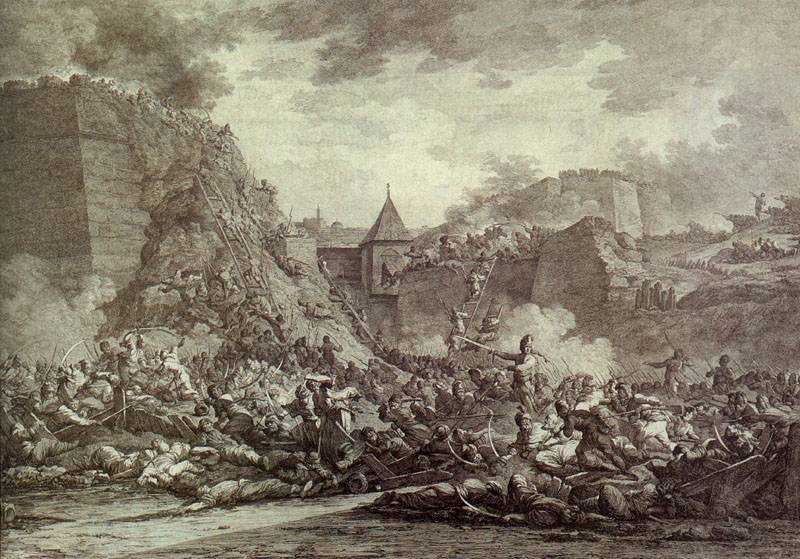
Storm Ochakov. Engraving by A. Berg 1792
Storm Ochakova
The main forces of the Russian army were linked with the siege of Ochakov. The commander in chief was extremely sluggish, for five months a large army stood under the walls of the fortress, where there was a 15-thousand. Turkish garrison under the authority of Hasan Pasha. The brave Suvorov, who led a part of the army, repeatedly offered to go on a decisive assault with the support of the Lmansk (Dnipro) flotilla, but Potemkin hesitated. The commander-in-chief decided to conduct a regular siege, fearing failure. The troops began to construct redoubts with artillery batteries to protect the flanks, then they planned to take the suburbs, move the guns forward, connect them with a trench and begin a methodical bombardment of the fortress, forcing the enemy to surrender. Undermining the walls was impossible because of the hardness of the soil.
During the siege, Russian troops repelled a series of attacks by the enemy garrison, which tried to prevent the engineering work. A particularly large attack was repelled July 27 (August 7) 1788. Suvorov personally led the two battalions of the grenadier to the counterattack and repulsed the enemy attack, while he was wounded. He offered to immediately go to the storming of the fortress and take it until the enemy came to his senses. However, Potemkin again refused to assault. The wounded Suvorov surrendered command of the troops to General Bibikov. During the siege of Ochakov, other Russian heroes were noted - Bagration, Kutuzov, Barclay de Tolly, Platov. So, when 18 (29) of August, the Ottomans again made a sortie from the Liman side on the left flank of the Russian army. In the course of the four-hour battle, the attack also repelled the Turks with killed and wounded people around 500, the Russians' losses amounted to 152 people. In this battle, distinguished himself and received a second wound in the head, Major-General Kutuzov, the chief of the Bug Yegersky Corps. A bullet hit him in the cheek and got out through the back of his head, he miraculously survived again.
The siege was very hard. The damp cold autumn was replaced by an early and fierce winter (it entered the memory of the people as Ochakovskaya for a long time). The army was ill prepared for the siege. The soldiers were in need of uniforms, supplies and fuel. In the bare steppe there was no forest for heating. There was no forage, almost all the cavalry dismounted. The soldiers froze in their mud huts and asked for an assault themselves in order to end the hateful siege more quickly. The troops lost in such conditions more people than in battles. Empress Catherine II, who was waiting for the news of the victory, was unhappy with her powerful favorite. The influence of his opponents grew. Rumyantsev’s stinging statement went on in Petersburg: “Ochakov is not Troy, in order to besiege him for ten years”. In November, the empress sent a rescript to the prince to finally take up the work energetically.
Plan of the Turkish fortress Ochakov, taken by Russian troops 6 December 1788 g. 1790-ies. Colorized engraving. Austria
Meanwhile, the enemy’s defense weakened. Russian troops approached the fortress and erected two lines of field fortifications, where 30 artillery batteries with 317 guns were placed. The bombing of Ochakov was conducted both from land and from ships of the flotilla. By early November, the Ottomans had lost most of the guns in the advanced fortifications. The bastion of the fortress, adjacent to the Estuary, was badly damaged. Most of the buildings in the city were destroyed or burned. In November, a flotilla of Cossack boats under the command of ataman Golovaty, covered by the ships of the Dnieper flotilla, made a swift raid on the fortified island of Berezan, located in front of Ochakov. The Ottomans capitulated, folded weapon 320 people. The Turks surrendered the keys to the fortress to the Cossacks, more 20 guns, 11 banners, 150 gunpowder buds and other supplies.
Only after the idea of a proper siege had failed, and the enemy still stubbornly refused to capitulate, did Potemkin decide to attack. It was necessary either to remove the siege and return in disgrace, or to undertake a desperate assault. The beginning of the attack was postponed several times due to bad weather conditions. In early December, the commander-in-chief approved the plan of operation prepared by General-in-Chief Meller. To ensure the surprise of the blow from the pre-shelling of the fortress refused. 6 (17) December 1788 of the year at 7 hour. in the morning at 20-degree frost 18, thousands of soldiers went on a decisive assault on Ochakov (in the siege corps itself, then there were about 21 thousand people). Six assault columns went into battle, which simultaneously attacked the earthworks surrounding the Ochakov fortress, Gassan Pasha castle and the fortress itself. Initially, earthworks were captured between the Ochakov fortress and the Gassan-Pasha castle. Then the Russian soldiers attacked the Turkish fortifications in the center and left the walls and gates of the fortress itself. Under the cover of artillery fire, the grenadiers broke into the walls and opened the gates for the troops who had seized the advanced fortifications. The Turks, knocked out of the city walls, sat down in houses, fought on the streets and put up desperate resistance. Hand-to-hand fight in the fortress itself took about an hour. The main part of the fighters in this fight died from cold weapons. There were practically no prisoners in the fortress itself.
Polish artist J. Sukhodolsky. "Storm of Ochakov"
The fight was bloody and extremely violent. Two thirds of the Turkish garrison was killed, 4500 was captured, including commandant Hasan Pasha (Hussein Pasha) and some 450 officers. The fortress was littered with bodies. There were so many corpses that without being able to bury them in the frozen ground, thousands of bodies were taken to the ice of the estuary, where they lay until spring. Trophies include 180 banners and 310 guns, as well as many weapons, equipment and various supplies.
Our casualties are 2289 people killed and wounded. It is clear that after the prolonged siege of Ochakov, Bender was out of the question. Potemkin took the army to the winter apartments, and he went to the capital. For the capture of Ochakov, the Most High Prince was awarded the Order of St. George 1 Art. and received other generous rewards. The siege corps was issued an additional semi-annual salary. In 1789, the medal “For the courage rendered during the capture of Ochakov” was instituted. The medal was awarded to the lower ranks and privates of the army, who took part in the siege and the storming of the Ottoman fortress. A total of 15384 silver medals were minted.
The capture of Ochakov was one of the most important events of the war and was included in the annals of the exploits of the Russian army. By the Yassky peace agreement 1791, Ochakov became part of the Russian Empire. This allowed Russia to secure the Northern Black Sea region - the Dnieper estuary and the surrounding area, to ensure the safety of Kherson, Nikolaev and the Crimean peninsula. No wonder contemporaries noted that "Ochakov is the southern natural Kronstadt."
Medal "For the courage rendered in the capture of Ochakov"
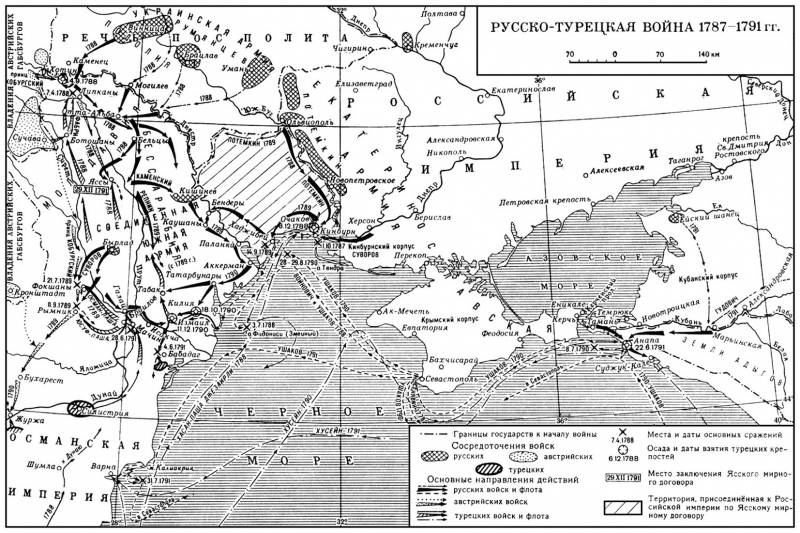
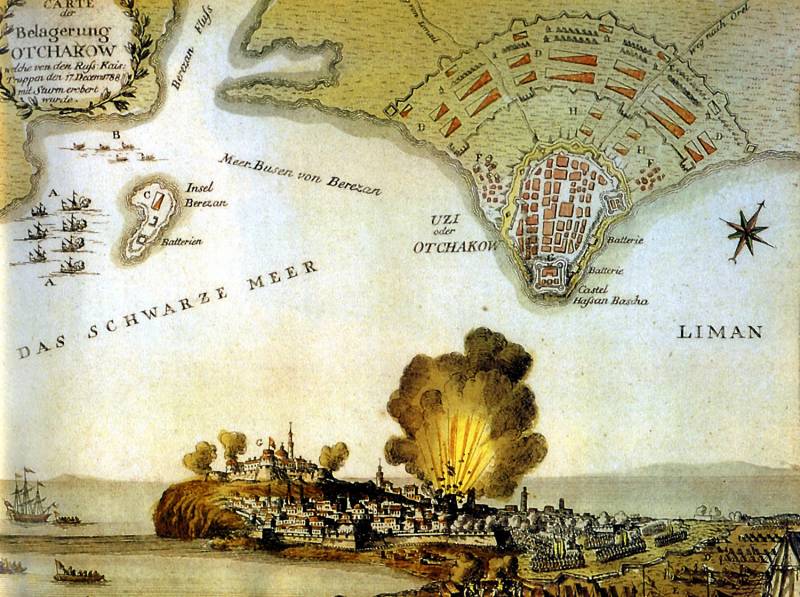
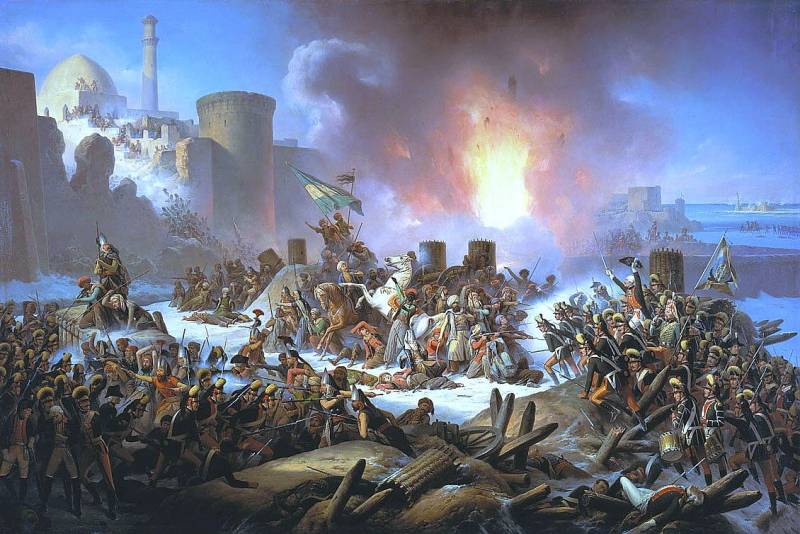
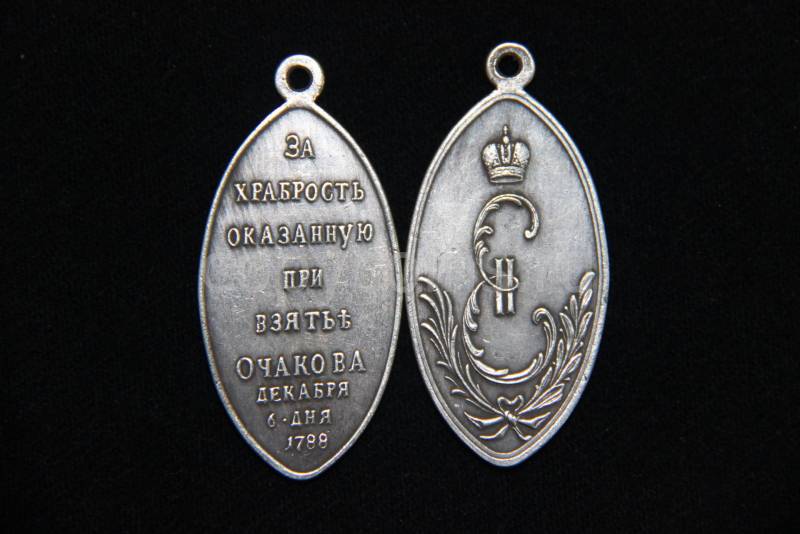
Information